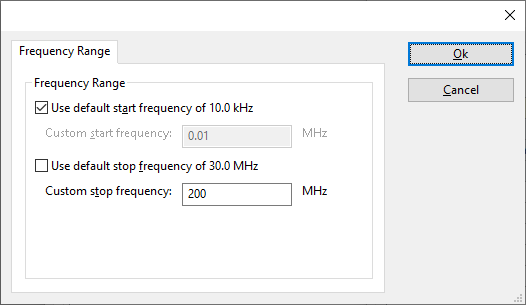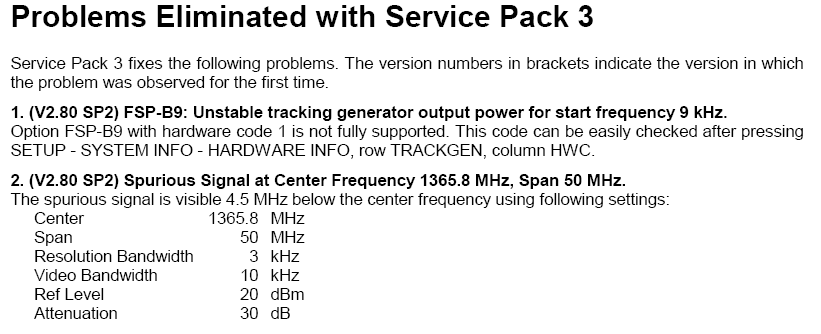Rohde & Schwarz FSP 13
The Rohde & Schwarz FSP 13 device driver is a Spectrum Analyser which is supported by RadiMation®.
Configuration[edit]
The following tabs are available in the advanced configuration of the Rohde & Schwarz FSP 13:
The frequency range of the Rohde & Schwarz FSP 13 as provided by the manufacturer is shown and selected as default. It is possible to overrule these frequencies and to manually adjust the allowed frequency range of the Rohde & Schwarz FSP 13.
| If the checkbox is checked, the default start frequency will be used as the lowest usable frequency in a test for this device. |
| If the Use default start frequency checkbox is unchecked, another start frequency (expressed in MHz) can be specified. The customized start frequency will then be used as the lowest usable frequency in a test for this device. The customized frequency can be a limitation or an extension of the default start frequency. |
| If the checkbox is checked, the default stop frequency will be used as the highest usable frequency in a test for this device. |
| If the Use default stop frequency checkbox is unchecked, another stop frequency (expressed in MHz) can be specified. The customized stop frequency will then be used as the highest usable frequency in a test for this device. The customized frequency can be a limitation or an extension of the default stop frequency. |
Specifying a different frequency range can be useful if for example:
- A device (like a coupler, antenna, injection device, cable, etc...) is still usable (but out of specification) outside the standard suggested frequency range.
- An external mixer is used to measure an extended frequency range.
- An up- or down-convertor is used to shift the frequency range.
- A newer model of a device is present that has an extended frequency range, and still uses the same remote control commands.
Be careful changing these settings as RadiMation® is no longer able to verify if the Rohde & Schwarz FSP 13 is used outside frequency range that is specified by the manufacturer. This may result in serious damage to your measurement device.
The FSP is a Spectrum analyser of Rohde & Schwarz.
The FSP is a simplified version of the ESIB and ESPI receivers. It has the same limitations as the ESPI, but it is also missing the 'Receiver' mode. This can however be depending on some optional modules.
The 2.80 embedded software series are NT 4 based, the 3.80 embedded software series are XP based
Documentation[edit]
- The user manual can be found here
- The programmer manual can be found here
- The release note for devices with XP as operating system can be found here
- The release note for devices with NT as operating system can be found here
- The release note for devices with NT Sp3 operating system can be found here
- Manual for the NT version can be found here and here
- The update for NT 2.80 SP3 can be downloaded here
Tips and tricks[edit]
The NT kernel version turns the display off when getting a *RST.
To turn it on again: SYSTEM:DISPLAY:UPDATE ON
reason for turning the display off is the performance hit given by the display.
The following tests has been performed on a R&S FSP30 to verify the functionality of the device driver
URL: http://www.rohde-schwarz.com/en/product/fsp-productstartpage_63493-8043.html
Performed Tests[edit]
General[edit]
- Model: Rohde & Schwarz FSP 30, 9kHz ... 30GHz
- Firmware version: 4.50 SP4, BIOS Rev. V3.0-10-2
- Preamplifier: not tested, option (B22) was not included
- Tracking generator: not tested, option was not included
- Communication over GPIB: Ok
- Test date: 2013 february 8th
Analyser mode[edit]
- RBW: Ok (tested: 1000 Hz, 3kHz, 9 kHz, 10 kHz, 100kHz, 120 kHz, 300 kHz, 1 Mhz)
- Reference Level: Ok
- Attenuator: Ok (tested: 0, 10, 20, 30, 40, 50, 60, 70 dB)
- Sweeptime: Ok (tested: 1000 us, 5 ms, 10 ms, 20 ms, 50 ms, 100 ms, 200 ms, 500 ms, 1000 ms)
- VBW: Ok (tested: 1000 Hz, 3kHz, 9 kHz, 10 kHz, 100kHz, 120 kHz, 300 kHz, 1 Mhz)
- Initial scans: Ok (tested: Peak, Peak + Average, Peak + Average + RMS, Peak + Average + RMS + QP)
- Final Measurement Peak Detector: Ok
- Final Measurement QP Detector: Ok
- Final Measurement AVG Detector: Ok
- Final Measurement RMS Detector: Ok

